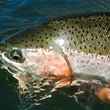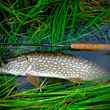Until one of my good friends became a custom rod builder, I was squarely under the assumption that having a custom fly rod built was a luxury intended specifically for grey-haired men who spent their evenings sitting in multi-million dollar fishing lodges drinking $200 bottles of scotch. In other words, guys who have money to burn on having a fly rod built to their exacting preferences. While this can certainly be the case, I've since learned that having a rod built to your custom specifications is not only for blue bloods with swollen bank accounts. In fact, having the rod of your dreams built by a custom rod maker can not only yield a rod that you've helped design every aspect of, but can also save you a considerable amount of money in the process.
To be clear, I'm not talking about custom bamboo rods built on rod-maker designed and crafted blanks. That's something I know nothing about and still, probably ignorantly, think of as a luxury confined to the aforementioned grey-haired blue blood crowd. I'm talking about that Sage One, Orvis Helios or R.L. Winston Boron IIx you've been eying up, but have been reluctant to drop $700-900 on. What if you could have that One or Helios, with custom designed aesthetics and hand-selected components and backed by the same warranty as you'd get buying from your local fly shop or online, all while saving as much as a hundred dollars or more in the process? This might not happen with every rod, but it is often the case.































